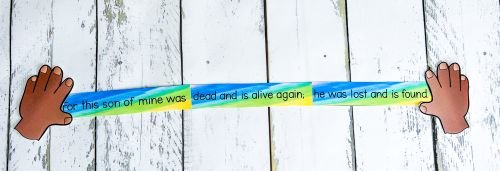Are you ready to learn about God’s great love for us through the parable of the Lost Sheep? Whether you're a Sunday school teacher, homeschooling parent, or work in a faith-based school, there are many engaging activities, crafts, videos, and printable lesson plans to bring this powerful parable of Jesus to life! Keep reading for easy-to-use resources to make teaching about The Lost Sheep meaningful and fun for kids in preschool through third grade.
THE parable of the lost sheep
The Parable of the Lost Sheep is found in Luke 15:3-7 and Matthew 18:12-14. A man had 100 sheep, and one was missing. He left the 99 sheep and searched for the one lost sheep. When he found the sheep, he rejoiced and invited all his friends to celebrate with him.
The Parable of the Lost Sheep - Bible Lessons for Kids
Are you looking for a simple way to teach the Parable of the Lost Sheep? Our scripted lesson plans, discussion questions, and printable crafts are perfect for children aged 3 to 8.
BACKGROUND INFORMATION ABOUT THE PARABLE OF THE LOST SHEEP
In this parable, God is the Shepherd, and we are the sheep. The Shepherd rejoices more over the lost sheep being found than the 99 sheep who never strayed. This parable teaches us that God rejoices when a sinner returns to Him.
The Pharisees would have seen themselves as part of the 99 who didn’t stray. It would have been shocking for them to hear that God rejoices more over sinners than over them. The Pharisees had a big problem with pride and thought they were better than others.
SHEPHERD OR SHEEP? - ACTIVITY FOR OLDER KIDS
A shepherd cares for the sheep and fights off danger. To protect the sheep, shepherds sleep in the pen entrance at night. They build dams to slow the water in streams and rivers so it is easier for the sheep to drink.
On the other hand, sheep cannot protect themselves, can’t hear very well, have bad eyesight, and get easily confused. They need a shepherd.
Turn these facts (and others) into a sorting activity. Have kids sort out cards with facts about shepherds and sheep into the appropriate categories. Then, discuss how we are like sheep and God is like the Shepherd. Check out The Parable of the Lost Sheep for Older Kids for sorting cards with facts about sheep and shepherds.
HOW TO DRAW A SHEEP ACTIVITY FOR OLDER KIDS
Learning to draw a sheep is a great way to make an artistic connection to this parable.
There are some adorable animated sheep out there. So why not teach your kids some step-by-step sheep drawings? Art Hub for Kids has a couple: How to Draw a Sheep for Preschool and How to Draw a Cartoon Sheep.
Or, if you prefer printable instructions, use the step-by-step printable instructions in The Parable of the Lost Sheep for Older Kids.
After drawing one sheep, challenge kids to draw more. After all, there are technically 100 sheep in this story!
Sheep and Shepherd Craft for Younger Kids
Cotton balls are a great way to give a sheep craft extra texture. Grab a bag or two from the store and let kids add them to their sheep crafts. This fun addition makes their creations look and feel more like real sheep.
Using the template pieces in The Parable of the Lost Sheep for Preschool, have kids color and cut out their shepherd and sheep pieces. Then use glue and cotton balls to give their sheep fluffy wool. They will love this simple, soft craft! As they create, encourage them to imagine how happy the shepherd must have been to find his lost sheep.
OTHER ACTIVITIES TO TEACH THE PARABLE OF THE LOST SHEEP
Find the Lost Sheep: Either print out pictures of sheep or get little sheep figurines or stuffed animals. Then, hide them around the room for kids to find.
Paper Plate Sheep Craft: Use a paper plate, cotton balls, googly eyes, and glue to create the cutest sheep craft! Check out This Craft Family for step-by-step instructions to make a paper plate sheep.
“Shepherd Says”: This game is similar to “Simon Says,” but uses the phrase “Shepherd says” instead. The leader is the shepherd, and the other kids are the sheep. The ‘shepherd’ will give simple instructions for the ‘sheep’, such as “Shepherd says walk to the walk” or “Shepherd says jump on your foot.”
Shepherd Mazes: Create an obstacle course using objects like tables, chairs, blankets, pillows, etc. Then, have kids do a “Follow the Leader” style game in which they follow the “shepherd” through the maze. The kid who is the shepherd gets to choose how the “sheep” maneuver around each object. For instance, they might go under the table and over the chairs.
YOUTUBE VIDEOS ABOUT THE PARABLE OF THE LOST SHEEP
YouTube is a great resource! But be sure to preview any videos you intend to show your kids for age-appropriateness and content. Here are some video suggestions:
This parable is part of a three-parable lesson that Jesus taught. This video by LifeKids teaches about all three parables: a lost sheep, a lost coin, and a lost son.
WANT TO CONTINUE LEARNING ABOUT THE PARABLES OF JESUS?
This lesson is part of a five-week series on the parables Jesus told. The other stories include The Wise and Foolish Builders, The Lost Coin, The Parable of the Sower, and The Prodigal Son.
These lessons about the Parables of Jesus are also included in the 52-week Bible curriculum for little kids in preschool/kindergarten and bigger kids in first, second, and third grades.
Teaching the Parable of the Lost Sheep in a creative and engaging way helps children understand God’s deep love and desire to bring everyone back to Him.























